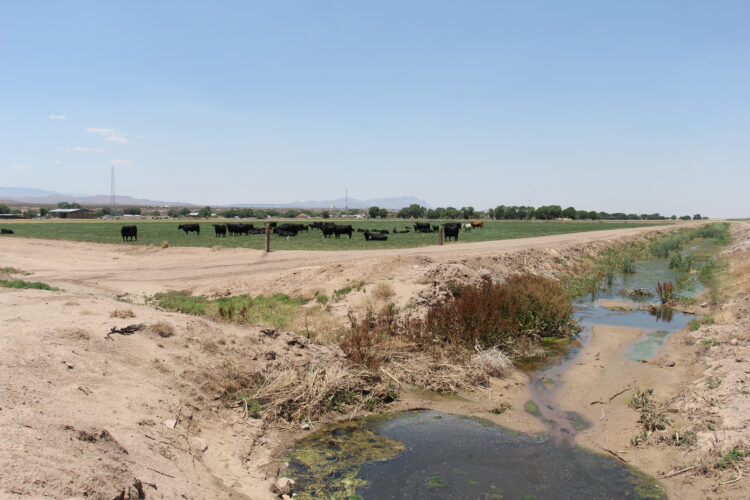
A small herd of cows graze in a pasture on the Harris farm Monday afternoon. The Harris’s are optimistic about having enough water to make it through the season.
Cathy Cook | El Defensor Chieftain
Some Socorro County farmers are feeling optimistic despite this year’s drought as a little more moisture comes to the area, but for others the future of farming looks bleak.
“I just hope it’s around for my kids,” said Matthew Harris, who’s feeling optimistic that the family farm will get enough rain this summer.
Four generations of Harris’s have farmed in San Antonio, New Mexico.
At first, Travis Harris, Matthew’s dad, heard they’d be out of water by the end of May.
“Last week I heard if it continues to rain up north maybe we’ll make it through the season,” he said.
Dennis Harris Jr.’s parents bought the farm in 1939. He grew up on the property and would like to see the farming tradition continue in his family.
The current drought reminds him of the dry weather in the 60s and early 70s, although that drought was harder on the Harris farm because there was less water control farther north in the river.
“Back then the river would go plum dry, because we didn’t have storage up north,” said Dennis Harris.
The year he got married, 1964, he had to pump water nearly all summer because the river was dry. Although more control over the river has made the drought easier on the Harris farm than it was in the 60s and 70s, hotter weather means when they can water, more is lost to evaporation.
“It was hot back then, but hundred-degree weather back then was very unusual,” said Dennis Harris. “Last summer we had hundred-degree weather for a month-long.”
Precipitation in the state has been on a declining slope for the last decade, said Joram Robbs, Executive Director of the New Mexico Chile Association. The current drought is particularly severe because the previous year’s monsoon season was weak, and because there was not much snowpack this year or the previous year, said Robbs. According to the drought monitor, 94.8 percent of the state is in severe drought and 74 percent is in extreme drought.
The irrigation season was ended 30 days early in the fall and began 30 days late this spring, reducing the number of times farmers were allowed to irrigate their fields. Robbs believes that urban areas should have more water restrictions before the government takes steps like shortening the irrigation season. The New Mexico Chile Association is also pushing to get funding for water infrastructure, like putting new concrete in ditches, and repairing dams and bridges, included in Biden’s infrastructure plan, said Robbs. Crumbling water infrastructure in the state contributes to water loss through absorption and evaporation, he said.
The drought is negatively impacting the chile industry, he said.
“Luckily a lot of chile farmers have pump irrigation, but even those are kind of scary because, without rain, it doesn’t refill the aquifer,” said Robbs.
Chile farmer Glen Duginns has adapted to the shortened irrigation season by transplanting his chile crop. He started his seeds in Arizona, then transplanted the crops back to New Mexico after he was allowed to irrigate. He is also using a well to supplement the irrigation water.
“On my farm, we’re going to pump and we’ve been pumping water, but it gets very very expensive and it adds salt to the land,” said Duggins.
In 2020, running water pumps cost him $12,000 in electricity, and this year he anticipates spending more. Duggins is afraid that it will become the norm to reduce the length of the irrigation season in future years. That’s one reason he was running for a seat on the Middle Rio Grande Conservancy District Board of Directors. The election for that position was held Tuesday.

Dennis Harris Jr. cuts hay Monday afternoon on the family farm. The hay will need to cure for several days before it is dry enough to be baled.
Cathy Cook | El Defensor Chieftain
The drought has spurred interest in buying, selling and leasing water rights, said Bill Turner, who runs the Albuquerque-based business Waterbank, a real estate firm dedicated to water rights and water-related transactions. Turner is also a registered hydrologist and geologist. Many industries besides agriculture also rely on access to water. Companies in the oil and gas industry need water to drill oil wells, high amounts of water are needed to manufacture computer chips and water is leased for dust control on construction projects, said Turner.
“I’ve had it happen several days now where I’ll sell a block of water rights between telephone calls,” said Turner.
Water rights and land rights are separate.
“The water right belongs to the use as does the land. So water can belong to an agricultural use as does the land. You have to have both to grow a crop. Water doesn’t belong to the land. Titles usually pass with the land,” said Turner.
When farmers in Socorro County don’t have water rights, they rely on water banking through the Middle Rio Grande Conservancy District, which allows them to lease rights and irrigate their crops.
Nick Carrasco has 78 acres of alfalfa and runs a few cows. It’s been over a year since he could water and his crop is dying. Last year in May, the MRGCD cut off water banking, which made it hard for farmers without water rights to irrigate their land.
Alfalfa can last eight or nine years before it has to be replanted. Although Carrasco only planted his four years ago, the alfalfa is dried out and not going to make it. Carrasco said he’s spent more on diesel than what the limited amount of alfalfa he’s been able to produce will bring in. He also has 30 head of cows that he sold at a loss in January, a ripple effect from the pandemic. Feedlots were full and would not accept any more cows last year as processing plants had to close due to COVID-19 outbreaks. Cows were not being processed, creating a beef shortage and price increases for consumers. Simultaneously, farmers were unable to sell their animals.
“So who’s making the money? It’s not the guys with the cows. It’s not the guy processing the meat, so it’s the market, the Walmart and the Smiths down the line. Somebody’s making the money, but it’s not us,” said Carrasco.
If Carrasco were in Valencia County, he said he’d develop and sell his farmland, but he doesn’t expect to get any good offers in Socorro County.
“The only ones that’s going to move in here is going to be the prairie dogs. They’re going to have plenty of room to roam here. It’s funny but it’s true. By next year they’ll have little dens,” said Carrasco.
On the 260 acre Harris farm, 107 acres had their water rights sold in previous years, so Travis Harris is trying to find water rights to lease. Harris began looking a month prior to irrigation season and still does not have 100 percent of the water rights he needs to irrigate all of the fields.
“The state engineer is so backed up with applications, their time frame is taking longer than normal and trying to find the water rights that we need is taking longer, because there’s other people looking for them and they may or may not be tied up,” said Harris.
Still, Harris is optimistic about the rest of the season. Carrasco thinks the future of farming looks bleak.
“The generations that are coming up, they don’t want to continue it and you can’t blame them. There’s easier ways to make a living,” said Carrasco.
Farmers are adapting to drought with new technologies and more drought-resistant plants, and doing things like switching from flood irrigation to drip irrigation.
“On my little farm, I have seven different varieties of alfalfa planted to try to have test plots to see if there’s a certain variety that requires less water but still produces a high-quality nutritional product at the end,” said Travis Harris.
Without water, the future of farming would be bleak, said Harris, but as long as water can be kept on the land sustainable agriculture will be possible.
“Just pray for water,” said Carrasco. “Politicians aren’t going to help us. It’s going to have to be the man upstairs who’s going to help us.”






















